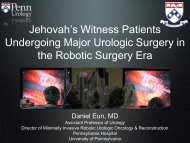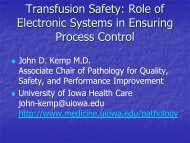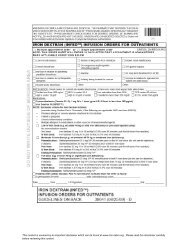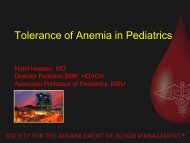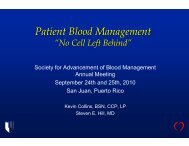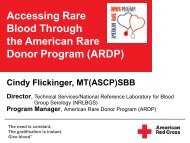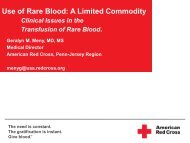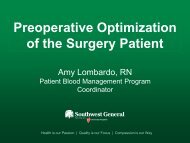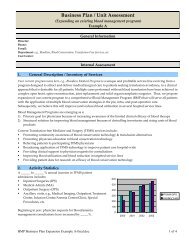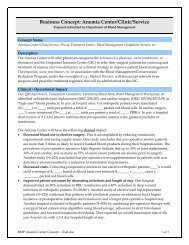SABM James D. Ferguson, Keith A. Samolyk, Victor Carcioppolo ...
SABM James D. Ferguson, Keith A. Samolyk, Victor Carcioppolo ...
SABM James D. Ferguson, Keith A. Samolyk, Victor Carcioppolo ...
Create successful ePaper yourself
Turn your PDF publications into a flip-book with our unique Google optimized e-Paper software.
Abstract<br />
Objective: During cardiopulmonary bypass (CPB), systemic coagulation is believed to become activated by blood<br />
contact with the extracorporeal circuit and by retransfusion of pericardial blood. To which extent retransfusion<br />
activates systemic coagulation, however, is unknown. We investigated to which extent retransfusion of pericardial<br />
blood triggers systemic coagulation during CPB. Methods: Thirteen patients undergoing elective coronary artery<br />
bypass grafting surgery were included. Pericardial blood was retransfused into nine patients and retained in four<br />
patients. Systemic samples were collected before, during and after CPB, and pericardial samples before<br />
retransfusion. Levels of prothrombin fragment F1+2 (ELISA), microparticles (flow cytometry) and non-cell bound<br />
(soluble) tissue factor (sTF; ELISA) were determined. Results: Compared to systemic blood, pericardial blood<br />
contained elevated levels of F1+2, microparticles and sTF. During CPB, systemic levels of F1+2 increased from 0.28<br />
(0.25—0.37; median, interquartile range) to 1.10 (0.49—1.55) nmol/l ( p = 0.001). This observed increase was similar<br />
to the estimated (calculated) increase ( p = 0.424), and differed significantly between retransfused and nonretransfused<br />
patients (1.12 nmol/l vs 0.02 nmol/l, p = 0.001). Also, the observed systemic increases of platelet- and<br />
erythrocyte-derived microparticles and sTF were in line with predicted increases ( p = 0.868, p = 0.778 and p = 0.205,<br />
respectively). Before neutralization of heparin, microparticles and other coagulant phospholipids decreased from<br />
464 mg/ml (287—701) to 163 mg/ml (121—389) in retransfused patients ( p = 0.001), indicating rapid clearance<br />
after retransfusion.<br />
Conclusion: Retransfusion of pericardial blood does not activate systemic coagulation<br />
under heparinization. The observed increases in systemic levels of F1+2,<br />
microparticles and sTF during CPB are explained by dilution of retransfused<br />
pericardial blood



